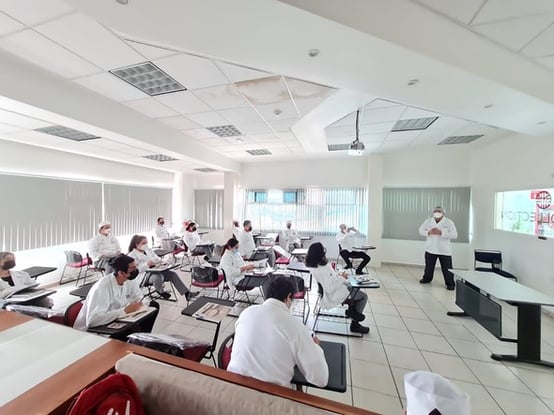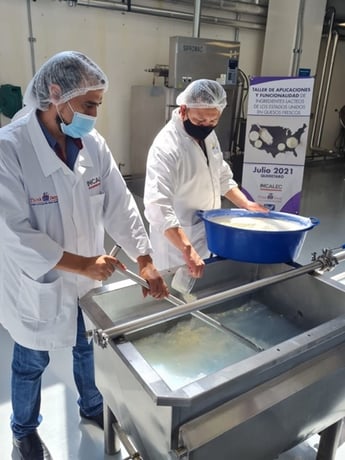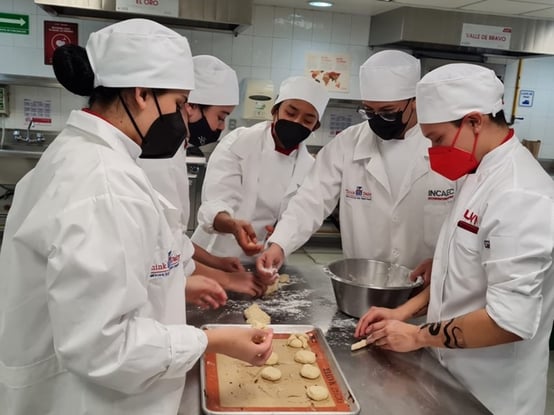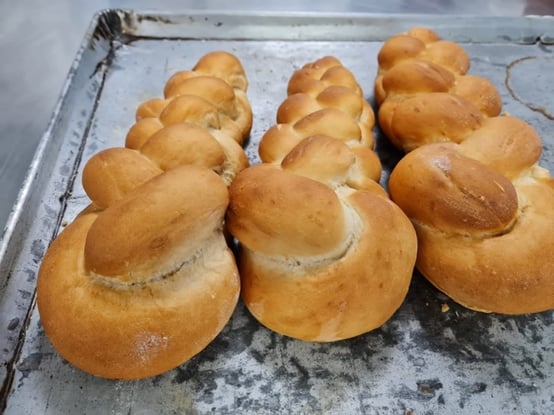-
Tapping a new dairy ingredient growth market in Mexico
By Paul Rogers March 7, 2022- Tweet
Educational opportunities lay the foundation for U.S. dairy ingredient growth in Mexico.
Mexico is home to hundreds of small and mid-size cheese manufacturers making popular local varieties like Panela, Oaxaca, Asadero, Añejo and Ranchero. The situation is similar in the bakery sector: Thousands of medium-sized bakeries are producing Mexican-style breads like Trenza, Bizcocho, Concha and special seasonal items like Pan de Muerto, made specifically for Day of the Dead festivities.Those local cheesemakers and bakers, when grouped with their peers, are sizable markets. In either sector, however, marketing individually to small and mid-size buyers with minimal knowledge of dairy ingredient benefits and functionality is quite a challenge.
A few years ago, the U.S. Dairy Export Council’s (USDEC’s) Ingredients Team sat down with USDEC’s Mexico team to figure out how to meet that challenge, and the results have been quite promising.
“We saw an opportunity not only because these small and mid-size companies were often overlooked by suppliers, but also because we knew greater engagement would lead to mutual benefits,” says Terri Rexroat, USDEC vice president, Global Ingredients Marketing. “Collectively, the business of these companies would mean incremental growth opportunities for U.S. dairy exports. On the other side, U.S. dairy ingredient solutions would help those Mexican manufacturers save money, improve their end products, help them better meet customers’ expectations and grow their businesses.”
Reaching the manufacturers was the challenge. To do so, USDEC developed a plan that centers on education, bringing together cheesemakers and bakers for sector-specific U.S.-dairy-ingredient-training workshops in partnership with regional universities and Mexican dairy and baking associations.
The workshops are structured as a mix of classroom and hands-on instruction, covering a range of U.S. dairy ingredients: nonfat dry milk/skim milk powder (NDM/SMP), whey protein concentrate (WPC), milk protein concentrate (MPC), sweet whey powder and lactose.
“The response was tremendous,” says Rodrigo Fernandez, director of the USDEC Mexico office. “In fact, there was so much demand that we significantly expanded the program dates to offer additional opportunities for people to attend.”

USDEC’s ingredient workshops for small and mid-size cheese and bakery manufacturers combine classroom and hands-on training. Here, instructor Gerardo Avena addresses a group of bakers at Universidad del Valle de Mexico in Mexico City.
What started as six planned workshops in the fall of 2020 grew into 50 in 2021—31 for cheesemakers and 19 for bakers. This aggressive in-person program was realized despite the limitations of the pandemic.
Workshops took place in nine Mexican cities in partnership with 11 institutions. More than 940 people attended, primarily cheese and bakery company representatives, but also professors, instructors and students from the partner institutions. Moving forward, USDEC is planning a strong program of workshops for additional participants for 2022 in several Mexican cities as well as expanding to Guatemala and the Dominican Republic.
“Many of the companies participating in the workshops had never been contacted by a supplier before,” said Rexroat. “So these workshops opened the door to a brand new and reliable customer audience for U.S. dairy ingredients. We see the effort as a path to building loyal customers and sustainable long-term business in Mexico.”
On top of that, the program led to two unique developments that were not even part of the original plan.
Official curriculum
The first development was with one of the schools that hosted the workshops: Tec de Monterrey, one of Mexico’s leading food technology schools. Starting in February 2022, Tec de Monterrey is incorporating U.S. dairy ingredients into its curriculum. It will offer for the first time a for-credit class to teach students how to use U.S. dairy ingredients in the manufacture of native Mexican cheeses.The idea for creating an official for-credit class to train students stems directly from the workshop series.
 Mexican cheesemakers incorporate NDM into hot water during the manufacture of fresh cheese at a USDEC workshop at the Tec de Monterrey pilot plant in Queretaro, Mexico.
Mexican cheesemakers incorporate NDM into hot water during the manufacture of fresh cheese at a USDEC workshop at the Tec de Monterrey pilot plant in Queretaro, Mexico.
Mexican bakers make mini Pan de Muerto using U.S. NDM and sweet whey powder at a USDEC workshop at Universidad del Valle de Mexico, Mexico City.
Tec de Monterrey educators sat in on some of the cheesemaking workshops and liked what they saw. While the university has a distinguished food science program, keeping up with the latest dairy ingredient developments proved a challenging task, in part due to insufficient domestic Mexican manufacturing capacity for such ingredients. The educators saw that the type of information the workshops were providing could help fill learning gaps.
“Mexican food science students are looking to learn about dairy ingredient innovations, new applications, functionality, cost-efficiency and nutrition, among other information,” said Dr. Ruben Zarraga, dairy science director and professor in charge of the Queretaro campus of Tec de Monterrey. “These students will be working with these ingredients in the future, so it is very important to have them ready for their professional challenges.”
The USDEC Mexico office talked with the university about the U.S. dairy portfolio and innovation capacity, emphasizing the strong U.S. position in the market as well as the ability to expand the market with new applications. (The U.S. has a 99% share of Mexico’s NDM imports, around 90% of its MPC and 80-85% of whey proteins.) In addition, they discussed the idea of converting aspects of the training to student-level learning. USDEC offered to support the efforts and is providing technical materials like monographs, brochures and the USDEC Milk Powder and Whey Proteins Reference Manuals for students.
“The university wants to keep students current on industry advances in food production technology—in this case for cheesemaking,” says Fernandez. “The university is planning for the future and understands that U.S. dairy ingredients are playing a key role in supplying an important portion of the dairy proteins and dairy solids in the Mexican market.”
There is also a direct commercial benefit to USDEC strengthening ties with Tec de Monterrey: The university offers consulting services to Mexico’s food processing sector, potentially exposing U.S. dairy ingredients and expertise to a larger food and beverage manufacturing audience.
.jpg?width=400&name=Mexico%20pic4%20(2).jpg)
Panela and ranchero cheeses made at USDEC ingredient workshops in Mexico using NDM and MPC 70%.

Trenza, a traditional Mexican braided bread, made at USDEC ingredient workshops using NDM and sweet whey.
New buying groups
The second development stemming from the workshop series is the creation of buying coalitions.
“A mid-size Mexican cheesemaker and distributor that participated in the workshops and saw the benefits of incorporating U.S. dairy ingredients in cheese manufacturing wanted to move forward and begin using U.S. milk powder and MPC,” explains Fernandez. “But buying individually in smaller quantities than major food and beverage processors, particularly at today’s prices and with an unfavorable exchange rate, would be difficult.”
The cheesemaker got together with peers to form buying coalitions in three regions in Mexico. The groups hope to buy in larger quantities, making purchases more economical.
“USDEC helped put the groups in touch with a list of importers and trading companies to facilitate business, and we know they have been in talks and even closed some deals,” says Fernandez.
Positioning for growth
The programs are making a difference. U.S. dairy ingredient exports to Mexico surged in 2021 compared to the previous year. U.S. NDM, MPC and WPC grew by double digits. It was a successful year, even though the gains were so sizable in part because of the large drop-off in U.S. shipments to Mexico in 2020, when demand and buying power were hit by the dual challenge of recession and pandemic.
The big gains in 2021 almost brought volumes back to pre-recession, pre-pandemic highs. And now U.S. dairy suppliers are well-placed for further growth.
“The strong U.S. market presence, the broad U.S. dairy ingredient portfolio, cutting-edge U.S. innovation capacity and the dedication of U.S. suppliers put us in a strong position in Mexico,” says Rexroat. “We know that activities like the workshops—and the cheesemakers and bakers they train—as well as the new for-credit university course and the buying coalitions are already paying dividends. And we believe they will help lay the groundwork for continuing, long-term demand growth for U.S. dairy ingredients in the years ahead.”
Paul Rogers is a correspondent for the U.S. Dairy Export Council who has covered the dairy industry for 25 years.
Subscribe to the U.S. Dairy Exporter Blog
The U.S. Dairy Export Council fosters collaborative industry partnerships with processors, trading companies and others to enhance global demand for U.S. dairy products and ingredients. USDEC is primarily supported by Dairy Management Inc. through the dairy farmer checkoff. How to republish this post.
10 Most Recent Posts
Most Popular Posts in Past Year
Index of Posts by Topic
- #GotDairyJobs (4)
- About USDEC (66)
- Africa (6)
- Australia (4)
- Blog (8)
- Brazil (4)
- Canada (20)
- Central America (1)
- Cheese (58)
- Chile (1)
- China (54)
- Common food names (7)
- Company News (19)
- Consistent Supply (1)
- Crisis Management (3)
- Cuba (2)
- Dairy (6)
- Dairy checkoff (9)
- Dairy Ingredients (5)
- Dairy Management Inc. (2)
- Dairy Resources (1)
- Dairy Supply Chain (1)
- Dairy Trends (5)
- Documentation (3)
- EU (24)
- Experts on Dairy Exports (4)
- Exporter of the Year (2)
- Exports (24)
- Farmer leaders (1)
- Farming (38)
- Food Aid (8)
- Food Safety (8)
- Foodservice (3)
- Free trade agreements (34)
- Future trends (1)
- Geographical Indications (GIs) (10)
- Global Marketing (86)
- Global Shipping Crisis (1)
- Got Jobs? (9)
- Indonesia (1)
- Innovation (17)
- Japan (17)
- Krysta Harden (1)
- Market Access (25)
- Market Conditions (268)
- Member Services (17)
- Mexico (41)
- Middle East (9)
- Middle East & North Africa (3)
- Middle East/North Africa (9)
- Milk (4)
- Milk Protein Concentrate (MPC) (2)
- New Zealand (11)
- Next5% (20)
- Nonfat Dry Milk/Skim Milk Powder (8)
- Nutrition (19)
- Product Innovation (6)
- Protein (4)
- Regulations (5)
- Research & Data (326)
- Russia (3)
- Singapore (10)
- South America (8)
- South Korea (10)
- Southeast Asia (25)
- Strategic Insights (1)
- Supply (1)
- Sustainability (26)
- Technology (2)
- ThinkUSADairy (5)
- TPM23 (1)
- TPP (13)
- Traceability (8)
- Trade Barriers (5)
- Trade Data (7)
- Trade Policy (72)
- TTIP (5)
- UHT Milk (7)
- USMCA (2)
- Vietnam (4)
- Whey (6)
- Whey Ingredients (2)
- Whey products (10)
- Whole Milk Powder (WMP) (3)
- World Dairy Expo (1)
- World Milk Day (1)
- Yogurt (1)
Index of Posts by Date, Author
- June 2021 (13)
- March 2015 (12)
- September 2015 (12)
- April 2015 (11)
- December 2015 (11)
- March 2014 (10)
- February 2015 (10)
- October 2015 (10)
- October 2014 (9)
- June 2015 (9)
- July 2015 (9)
- November 2015 (9)
- March 2016 (9)
- October 2019 (9)
- September 2013 (8)
- May 2015 (8)
- August 2015 (8)
- January 2016 (8)
- February 2016 (8)
- March 2017 (8)
- December 2018 (8)
- May 2019 (8)
- December 2019 (8)
- June 2014 (7)
- November 2016 (7)
- May 2017 (7)
- May 2018 (7)
- July 2020 (7)
- June 2023 (7)
- July 2016 (6)
- August 2018 (6)
- October 2018 (6)
- November 2018 (6)
- February 2019 (6)
- June 2019 (6)
- August 2019 (6)
- March 2020 (6)
- April 2020 (6)
- June 2020 (6)
- June 2022 (6)
- February 2014 (5)
- June 2016 (5)
- August 2016 (5)
- September 2016 (5)
- December 2016 (5)
- February 2017 (5)
- July 2017 (5)
- October 2017 (5)
- January 2018 (5)
- April 2018 (5)
- June 2018 (5)
- July 2018 (5)
- September 2018 (5)
- January 2019 (5)
- March 2019 (5)
- April 2019 (5)
- July 2019 (5)
- September 2019 (5)
- November 2019 (5)
- January 2020 (5)
- August 2020 (5)
- October 2020 (5)
- April 2021 (5)
- January 2022 (5)
- May 2013 (4)
- September 2014 (4)
- April 2016 (4)
- May 2016 (4)
- October 2016 (4)
- January 2017 (4)
- April 2017 (4)
- June 2017 (4)
- August 2017 (4)
- September 2017 (4)
- December 2017 (4)
- February 2018 (4)
- February 2020 (4)
- May 2020 (4)
- February 2022 (4)
- September 2022 (4)
- April 2023 (4)
- December 2023 (4)
- November 2017 (3)
- March 2018 (3)
- September 2020 (3)
- December 2020 (3)
- February 2021 (3)
- May 2021 (3)
- August 2021 (3)
- December 2021 (3)
- March 2022 (3)
- April 2022 (3)
- May 2022 (3)
- October 2022 (3)
- December 2022 (3)
- May 2023 (3)
- July 2023 (3)
- November 2023 (3)
- March 2011 (2)
- June 2011 (2)
- September 2011 (2)
- March 2012 (2)
- June 2012 (2)
- July 2012 (2)
- March 2013 (2)
- July 2013 (2)
- November 2020 (2)
- January 2021 (2)
- March 2021 (2)
- July 2021 (2)
- September 2021 (2)
- October 2021 (2)
- November 2021 (2)
- July 2022 (2)
- August 2022 (2)
- January 2023 (2)
- March 2023 (2)
- October 2023 (2)
- January 2024 (2)
- February 2024 (2)
- April 2024 (2)
- June 2024 (2)
- July 2024 (2)
- November 2024 (2)
- December 2024 (2)
- February 2025 (2)
- June 2025 (2)
- July 2025 (2)
- September 2025 (2)
- November 2025 (2)
- January 2010 (1)
- February 2010 (1)
- March 2010 (1)
- April 2010 (1)
- May 2010 (1)
- June 2010 (1)
- July 2010 (1)
- August 2010 (1)
- September 2010 (1)
- October 2010 (1)
- November 2010 (1)
- December 2010 (1)
- January 2011 (1)
- February 2011 (1)
- April 2011 (1)
- May 2011 (1)
- July 2011 (1)
- August 2011 (1)
- October 2011 (1)
- November 2011 (1)
- December 2011 (1)
- January 2012 (1)
- February 2012 (1)
- April 2012 (1)
- August 2012 (1)
- September 2012 (1)
- October 2012 (1)
- November 2012 (1)
- December 2012 (1)
- January 2013 (1)
- February 2013 (1)
- April 2013 (1)
- June 2013 (1)
- August 2013 (1)
- October 2013 (1)
- November 2013 (1)
- December 2013 (1)
- January 2014 (1)
- April 2014 (1)
- May 2014 (1)
- November 2022 (1)
- February 2023 (1)
- August 2023 (1)
- September 2023 (1)
- March 2024 (1)
- May 2024 (1)
- August 2024 (1)
- September 2024 (1)
- October 2024 (1)
- January 2025 (1)
- March 2025 (1)
- April 2025 (1)
- May 2025 (1)
- August 2025 (1)
- December 2025 (1)
- USDEC (183)
- USDEC Staff (163)
- Alan Levitt (119)
- Tom Suber (41)
- Margaret Speich (22)
- Marc A.H. Beck (15)
- Vikki Nicholson-West (11)
- Angélique Hollister (11)
- Tom Vilsack (8)
- Jaime Castaneda (7)
- Matt McKnight (7)
- Véronique Lagrange (7)
- Margaret Speich and Mark O'Keefe (7)
- Ross Christieson (7)
- Paul Rogers (6)
- Shawna Morris (5)
- William Loux (5)
- Alan Levitt and Marc Beck (5)
- Krysta Harden (4)
- USDEC Communications (3)
- Kristi Saitama (3)
- Marilyn Hershey (3)
- Brad Gehrke (3)
- Tom Quaife (2)
- Nick Gardner (2)
- Jim Mulhern (2)
- Alan Levitt and William Loux (2)
- Kara McDonald (2)
- Luke Waring (2)
- Merle McNeil (2)
- Andrei Mikhalevsky (1)
- Rodrigo Fernandez (1)
- Dermot Carey (1)
- Jeremy Travis (1)
- Annie Bienvenue (1)
- Ross Christieson and Shawna Morris (1)
- Becky Nyman (1)
- Paul Rogers and Tom Quaife (1)
- Rick Ortman (1)
- Tony Rice (1)
- Barbara O’Brien (1)
- Paul Rogers and Mark O'Keefe (1)
- Dalilah Ghazalay (1)
- Amy Wagner (1)
- Mitchell Bowling (1)
- Erica Louder (1)
- Brad Scott (1)
- Amy Foor (1)
- Scott Lantz (1)
- Sandra Benson (1)
- Errico Auricchio (1)
- Jaclyn Krymowski (1)
- Krysta Harden, USDEC President and CEO (1)
.png)

